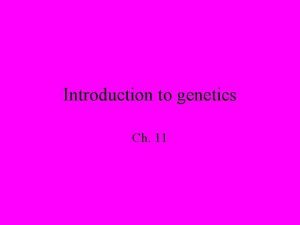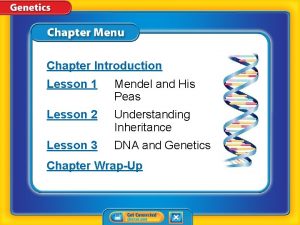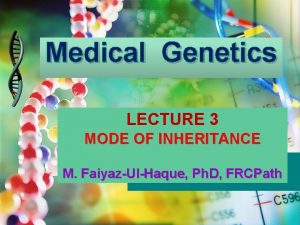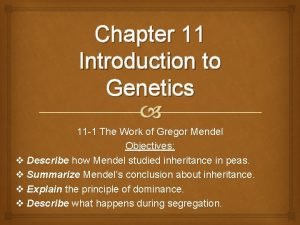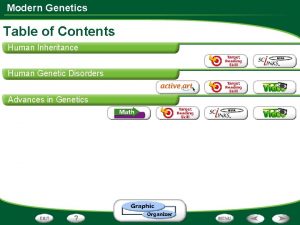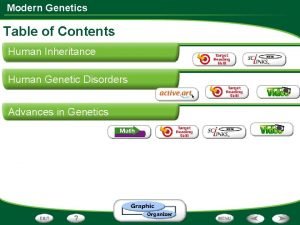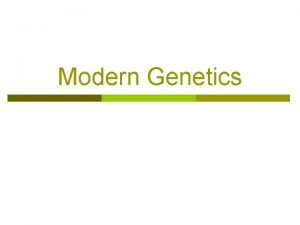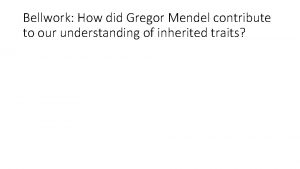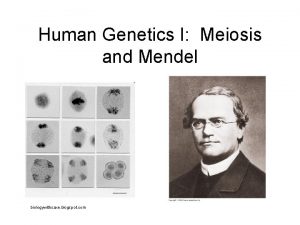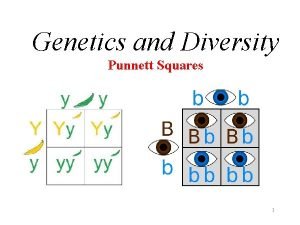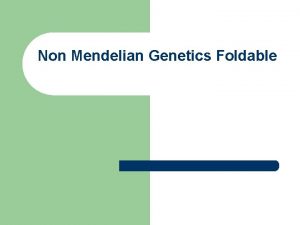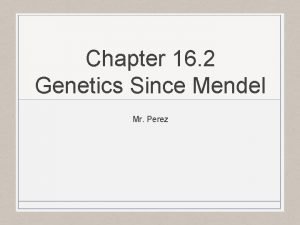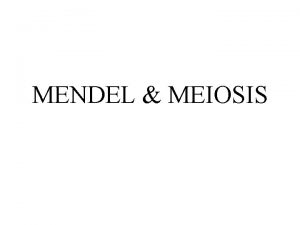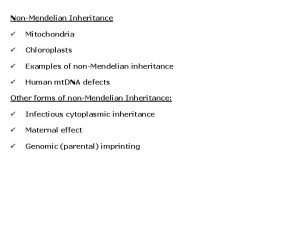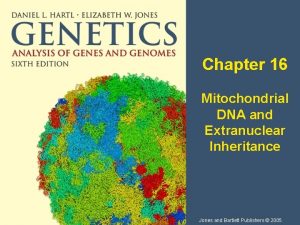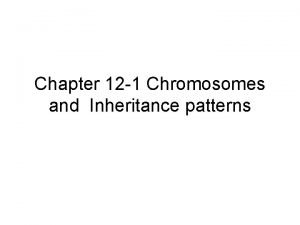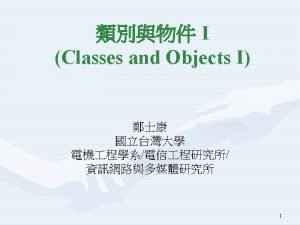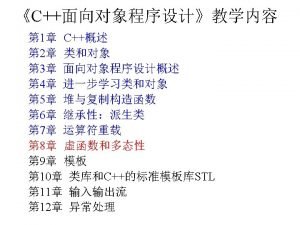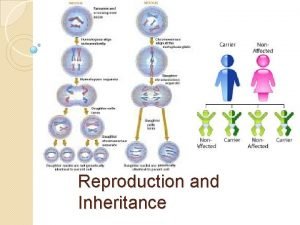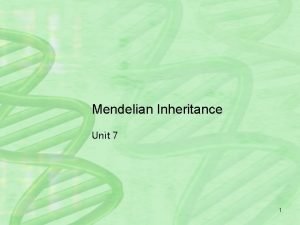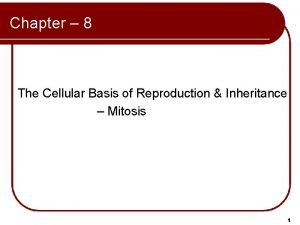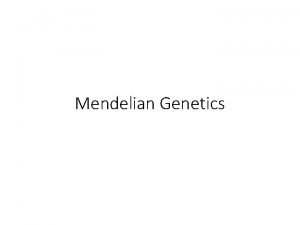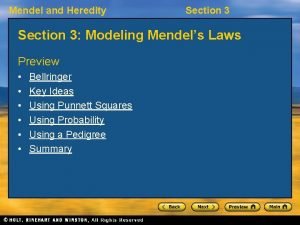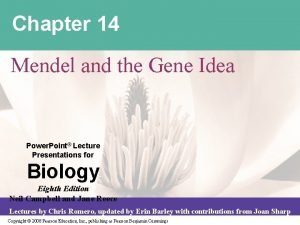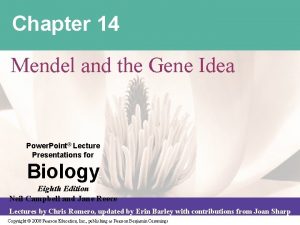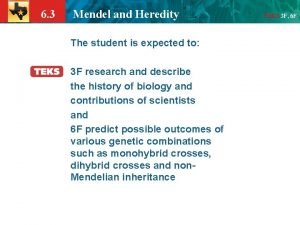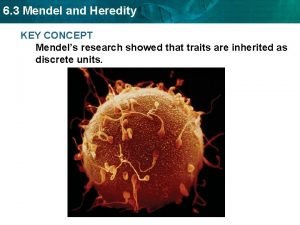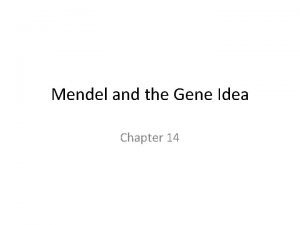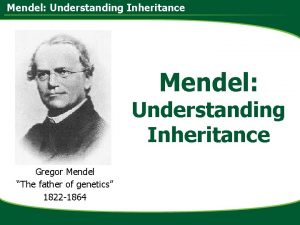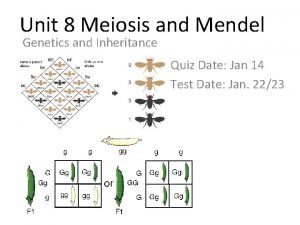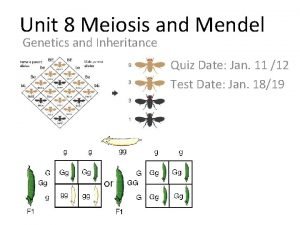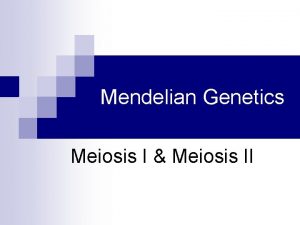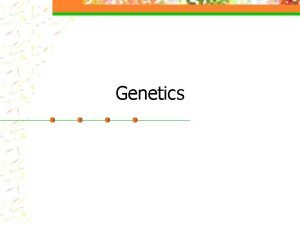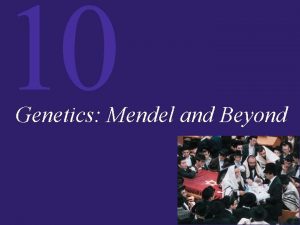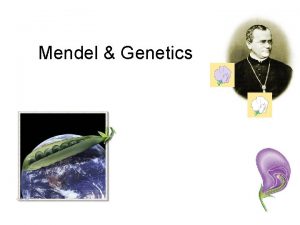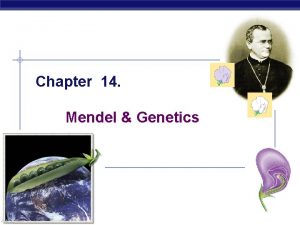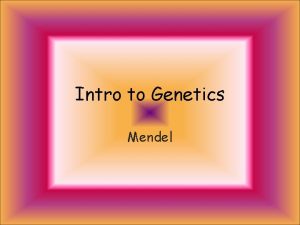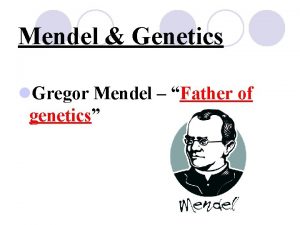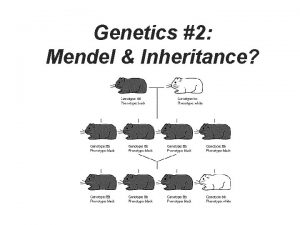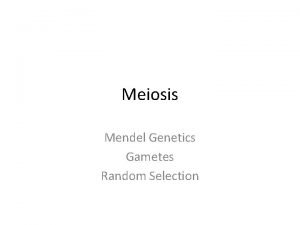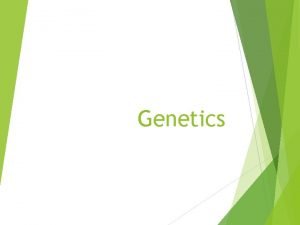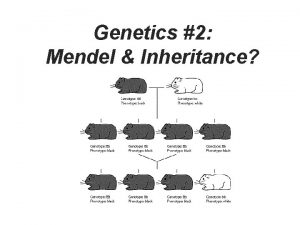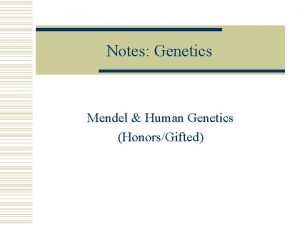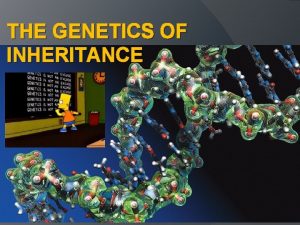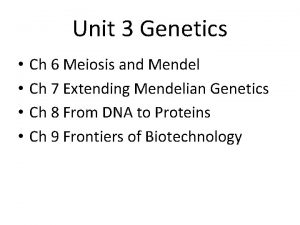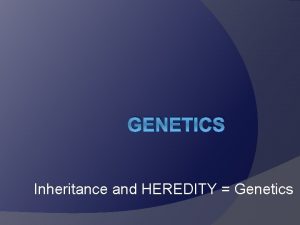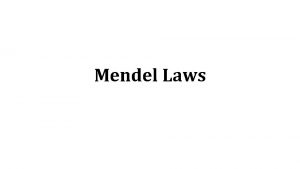Unit 8 Meiosis and Mendel Genetics and Inheritance






















































- Slides: 54

Unit 8 Meiosis and Mendel Genetics and Inheritance Quiz Date: Jan. 11 /12 Test Date: Jan. 18/19

UNIT 8 - INTRODUCTION TO GENETICS • Although the resemblance between generations of organisms had been noted for thousands of years, it wasn’t until the 1800 s that scientific studies were carried out to develop an explanation for this. Today we know that we resemble our parents because of ________, which is the set of characteristics we receive from ___________. The study of heredity is known as _________. our parents genetics


I. SEXUAL REPRODUCTION & MEIOSIS (pp. 275 -278) • In sexual reproduction, an egg and sperm cell fuse together to create a fertilized egg or ________. zygote

A. Chromosome Number 1. Somatic Cells - _______ Body cells Human somatic cells contain ____ 46 chromosomes _______ or ____ meaning they contain a Diploid 2 n ______ set of chromosomes, half ( _____23) from double _____ Dad and half from ____. Mom “Matching” chromosomes are known as _____________________. Homologous pairs A homologous pair is made up of a copy of a chromosome from each parent, with the same ______. genes

Homologous Chromosomes

GAMETES 2. Gametes - ______ Egg and ________ Sperm cells Human gametes contain ______23 chromosomes. _______ or ______ meaning there is _____ Haploid n setone of instructions for each ______. gene When gametes fuse together in ___________, the zygote fertilization ________ diploid produced is _______ 46 and has _______ chromosomes.

Haploid vs. Diploid Karyotypes

B. Meiosis Special type of cell division that only occurs in specialized germ cells (sex cells) in ______ of femalesovaries and _______ oftestes males. In meiosis, DNA is replicated once but cell divides ________, resulting in ______ 2 X, two times 4 cells with _______ 1/2 the original chromosome number.

MEIOSIS In females, process is known as ____________. oogenesis In males, process is known as _____________. spermatogenesis In both males & females, prior to meiosis I, DNA is replicated during ______ of ____________. S interphase

Meiosis occurs in two stages:

1. Meiosis I Prophase I Unlike in prophase of mitosis, In prophase I______________ come together to form Homologous pairs a _______. tetrad Tetrads are held together at the __________. centromeres

Crossing Over Meiosis I Exchange of genetic information between a ________________ with its Sister chromatid __________________. Non-sister homologue Occurs very frequently Allows for _____________. Genetic variation

Meiosis I Metaphase I _______________ align in equator of Tetrads cell Each homologue consists of ____________________. Two sister chromatids Anaphase I _____________________ Homologous pairs _ are pulled apart _________, Centromeres Sister chromatids _____________ still intact

Meiosis I Telophase I Two cells are formed, each with _______ 23 chromosomes Each chromosome still composed of two __________ Sister chromatids Two cells produced at the end of meiosis I are ________ haploid There are no homologous pairs present because___________

MEIOSIS II

2. Meiosis II Continues with the two cells formed moving directly into prophase II without any further ___________ of DNA. Inreplication anaphase II, ___________ are pulled apart. Sister chromatids Two new cells are formed from each of the two cells formed in meiosis I, resulting in a total of ______ new cells, each with ______the original number of chromosomes. 4 Cells produced are called __________. 1/2 Gametes

3. Oogenesis vs. spermatogenesis • Spermatogenesis: Males produce 4 viable sperm cells • Begins: puberty ______ • Ends: death ______

3. Oogenesis vs. spermatogenesis • Oogenesis: Females produce only one egg and 3 polar bodies • Begins: ______ Before birth • Ends: ______ menopause

II. HISTORY OF GENETICS (pp. 263 -270) • A. Gregor Mendel Known as the “Father of ________” Genetics Famous for his experiments with ____ peaplants.

Mendel Used true-breeding pea plants, which means ____________; characteristics always pureline, purebred show. Known as the ______Pgeneration. Studied seven _______, including plant height, seed color, flower color, etc. traits o A trait is an ________________. Inherited characteristic

Mendel Pea plants cross-pollinate, meaning pollen from one plant fertilizes an egg from another, but they can also self-pollinate, meaning pollen can fertilize egg from _______ plant. Mendel controlled same the fertilization process of the pea plants by preventing _________________ and controlling Self-pollination __________________. Cross-pollination

Pea Traits Studied •

B. Mendel’s Results P generation – Crossed _________ True-breedingplants with one trait with ________ plants with the other. True-breeding For example, TT (tall) x tt (short) _______________________ F 1 generation – Offspring produced from _________. In F 1, one. P trait tall plants X short plants = X P______. For example, disappeared _____________. F 2 generation All tall– Offspring plantsproduced from _________. In F 2, trait that disappeared in F 1 reappeared in _____ of the. F 1 offspring; X F 1 the other ¾ showed _______________. 1/4 Dominant trait


Mendel’s Principles • C. Mendel’s Principles – After analyzing his results carefully, Mendel formed conclusions that increased understanding of inheritance and opened the door for the study of genetics. Individual units called ______ determine inheritable characteristics. A gene is a portion ofgenes ______ that codes for a specific ______. DNA trait

Alleles and Genes

Mendel’s Principles For each gene, an organism inherits two alleles, one from each _________. Alleles are different forms or parent __________ of a ______. For any given gene versions trait, homozygous its alleles are the same and the o If an organism is __________, trait will be expressed. o If the alleles differ, the organism is said to be __________ for thatheterozygous trait and only one allele will be expressed. The expressed allele is the _______ allele, designated by andominant _____-case letter. The allele that is not expressed in a heterozygous trait is upper _________, designated by a _______-case recessive letter. A recessive allele is only lower expressed when an organism is ________. homozygous

Mendel’s Principles Principle of Segregation - In meiosis, the two alleles for a trait segregate (________). separate Each egg or sperm cell receives a copy of one of the two alleles present in the somatic cells of the organism. There is a _____ chance that a copy of that allele will end up 50% in the gamete produced. Principle of Independent Assortment – The way one pair of alleles segregates has no influence on any other pair of alleles.

Independent Assortment


D. Genetics Terminology • 1. Phenotype - ________ description of trait; Physical for example, _______ Tall, short • 2. Genotype – Genetic make-up of an organism or set of alleles; for example, __________. TT, Tt, heterozygous, etc. .

Genetics Terminology • 3. Application of Terminology - If round pea seeds are dominant to wrinkled pea seeds, round is designated _____ and wrinkled is designated R ______. • a. r Homozygous dominant • Genotype = ____; Phenotype = ____ • b. Heterozygous RR round • Genotype = ____; Phenotype = ____ • c. Homozygous recessive round Rr • Genotype = ____; Phenotype = ____ rr wrinkled


III. ANALYZING INHERITANCE (pp. 135 -137) • A. Probability segregation Due to the law of________, if you know the genotype of the parents, you can predict the likelihood of a trait occurring in the offspring. Probability can be written 3 ways. The probability of a coin coming up heads after being flipped is (fraction) _____, 1/2 (ratio) ____, or (percent) _______. 50% 1: 2

B. Punnett Squares • A Punnett square is a tool used to predict the possible outcomes of ________ and meiosis __________; in other words, a Punnett fertilization square is used to determine the probability of certain traits appearing in offspring.

Punnett Practice Monohybrid crosses A-D • • Must have a key And Cross with Each problem For full credit

A: Construct a Punnett square to determine the probability of white flowers is a heterozygous purple flower (Pp) is crossed with a homozygous white flower (pp) P=purple, p=white 1. Key: ____________ 2. Cross: ________ Pp X pp p p Pp pp 50% Probability of White flowers: ______

B: Construct a Punnett square to determine the probability of short pea plants if a homozygous tall plant (TT) is crossed with a heterozygous tall plant (Tt) T=tall, t=short 1. Key: _________ 2. Cross: ________ TT X Tt T T 0% Probability of short pea plants: ______ T TT TT t Tt Tt 100% Probability of tall pea plants: ______

C: If round peas are dominant over wrinkled peas, make a Punnett square to determined the genotype and phenotype ratios of the offspring if a heterozygous plant is crossed with a homozygous recessive plant R=round, r=wrinkled 1. Key: _________ 2. Cross: ________ Rr X rr R r r Rr rr RR: Rr: rr 0: 2: 2 Genotypic ratio: _________ 2: 2 Phenotypic ratio: _________

D: Use a Punnett square to determine the genotype and phenotype ratios of the offspring from a cross between a homozygous dominant yellow pea plant and a homozygous recessive green pea plant Y=yellow, y=green 1. Key: _________ 2. Cross: ________ YY X yy Y Y y Yy Yy YY: Yy: yy 0: 4: 0 Genotypic ratio: ________ 4: 0 Phenotypic ratio: _________

Dihybrid crosses The punnett squares we have been doing are known as __________ crosses, monohybrid meaning that only one traits has been considered 2 at a time. In a dihybrid cross, _____ genes different _______ on 2 different _______ chromosomes are analyzed.

Punnett Practice dihybrid crosses A -B 1. Key 2. Cross 3. Punnet square

A. Peas homozygous for round shape and heterozygous for color are crossed with yellow peas heterozygous for shape Key: R=round, r=wrinkled Y=yellow, y=green Cross: ___________ Genotypic ratio: ___________________________ Phenotypic ratio: ______________

B. Key: G= gray body, g= black body; R=red eyes, r =black eyes Cross: GGRr X Ggrr What are the phenotypes of the parent fruit flies: ______________ Genotypic ratio: ______________ Phenotypic ratio: ______________

Incomplete Dominance • Neither allele has “complete” dominance over the other; heterozygous phenotype is a blend of the 2 homozygous phenotypes • Ex: snapdragons R = red W = white RW = pink

Incomplete Dominance: cross a pink snapdragon with a white snapdragon 1. Key: _____________ 2. Cross: ____________ Phenotypic ratio: __________ Genotypic ratio: __________

Incomplete Dominance: cross a red snapdragon with a white snapdragon 1. Key: _____________ 2. Cross: ____________ Phenotypic ratio: __________ Genotypic ratio: __________

Codominance • Codominance – Both alleles share dominance and are always expressed if present. • Ex: In chicken B = black feathers X W = white feathers BW = black AND white feathers

Codominance: cross a pink snapdragon with a white snapdragon 1. Key: _____________ 2. Cross: ____________ Phenotypic ratio: __________ Genotypic ratio: __________

Codominance: cross a pink snapdragon with a white snapdragon 1. Key: _____________ 2. Cross: ____________ Phenotypic ratio: __________ Genotypic ratio: __________

Polygenic Traits • “Many genes” ; Many traits are controlled by more than one gene; have a variety of choices for expression. • Ex: _hair color, eye color, skin tone

Multiple Alleles • Many genes that have more than 2 alleles, although an individual only has 2 alleles for the gene. • Ex: blood group. • There are 3 possible • alleles for this gene.

Suggested study questions • p. 283 (1 -5, 11, 12, 17 -20)
 Mendel's first and second law of inheritance
Mendel's first and second law of inheritance Solid
Solid Mendel's 3rd law of inheritance
Mendel's 3rd law of inheritance What did mendel conclude determines biological inheritance
What did mendel conclude determines biological inheritance 3 laws of inheritance
3 laws of inheritance Punnet square
Punnet square What are mendelian traits
What are mendelian traits Human inheritance modern genetics answer key
Human inheritance modern genetics answer key Genetics graphic organizer
Genetics graphic organizer Modern genetics human inheritance answer key
Modern genetics human inheritance answer key Gregor mendel a monk
Gregor mendel a monk Gregor mendel
Gregor mendel Chapter 11 biology review answers
Chapter 11 biology review answers How did gregor mendel contribute to genetics
How did gregor mendel contribute to genetics Meiosis
Meiosis Eye color punnett square
Eye color punnett square Mendel's genetics foldable
Mendel's genetics foldable Genetics since mendel
Genetics since mendel Sexual reproduction and genetics section 1 meiosis
Sexual reproduction and genetics section 1 meiosis Sexual reproduction and genetics section 1 meiosis
Sexual reproduction and genetics section 1 meiosis Mendel meiosis
Mendel meiosis Crossing over during prophase 1
Crossing over during prophase 1 Differentiate between chromosome and chromatid
Differentiate between chromosome and chromatid Chapter 10 section 1: meiosis
Chapter 10 section 1: meiosis Chapter 10 section 1 meiosis
Chapter 10 section 1 meiosis Anaphase
Anaphase Tetrad meiosis
Tetrad meiosis Prophase of meiosis 2
Prophase of meiosis 2 Unit 6 review questions
Unit 6 review questions Transovarial transmission คือ
Transovarial transmission คือ Advantages of inheritance
Advantages of inheritance Extranuclear inheritance
Extranuclear inheritance Section 12-1 chromosomes and inheritance
Section 12-1 chromosomes and inheritance Chapter 11 complex inheritance and human heredity test
Chapter 11 complex inheritance and human heredity test Encapsulation inheritance polymorphism
Encapsulation inheritance polymorphism Oops abstraction encapsulation inheritance polymorphism
Oops abstraction encapsulation inheritance polymorphism Reproduction and inheritance
Reproduction and inheritance Family resemblance test
Family resemblance test Harry potter and the inheritance of sex
Harry potter and the inheritance of sex The cellular basis of reproduction and inheritance
The cellular basis of reproduction and inheritance Who is gregor mendel and what is he famous for
Who is gregor mendel and what is he famous for Laws of segregation and independent assortment
Laws of segregation and independent assortment Section 3 mendel and heredity
Section 3 mendel and heredity Mendel university faculty of business and economics
Mendel university faculty of business and economics Section 3 mendel and heredity
Section 3 mendel and heredity Mendel's law of independent assortment and segregation
Mendel's law of independent assortment and segregation Mendel and the gene idea chapter 14
Mendel and the gene idea chapter 14 Chapter 14 mendel and the gene idea
Chapter 14 mendel and the gene idea Who is gregor mendel and what did he do?
Who is gregor mendel and what did he do? Mendel 9 3 3 1
Mendel 9 3 3 1 Mendel university fees
Mendel university fees Section 3 mendel and heredity
Section 3 mendel and heredity Section 3 mendel and heredity
Section 3 mendel and heredity Mendel university faculty of business and economics
Mendel university faculty of business and economics Chapter 11 mendel and the gene idea
Chapter 11 mendel and the gene idea
